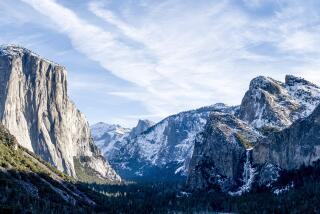A mega-quake stretching from L.A. to San Francisco would devastate California, with $289 billion in losses, study finds

Scientists say they’ve found a way to give you a little extra warning before an earthquake strikes.
- Share via
A sobering new report on California’s seismic vulnerabilities said that up to 3.5 million homes could be damaged if an 8.0 earthquake ruptured on the San Andreas fault.
The new estimate, from the data firm CoreLogic, is based on a theoretical rupture of the entire San Andreas fault, which passes through Los Angeles County and the San Francisco Bay Area and spans more than 800 miles, from the Pacific Ocean south of Eureka to Imperial County near the Mexican border.
Scientists now say it is possible — although not likely — that the northern and southern sections of the San Andreas fault can rupture simultaneously.
The cost of reconstruction could be greater than $289 billion.
The CoreLogic report was calculated based upon a new government forecast on earthquake risks released about a year and a half ago, which accepted the possibility — however remote — of a San Andreas fault earthquake simultaneously striking Northern and Southern California.
Scientists had long thought that no large earthquakes could occur on a so-called “creeping” section of the San Andreas fault in San Benito and Monterey counties. Creeping sections of the faults generally produce small earthquakes, like those magnitude 5 or less, but were not thought to produce large ones.
“Locked” sections of faults, meanwhile, are the ones we generally worry about, gathering stress over decades or centuries, and building strain to be released in a catastrophic earthquake someday.
Researchers had long believed that the central San Andreas’ creeping section essentially acted as a barrier for the fault, dividing it into two sections. Such a division would have meant that the same San Andreas earthquake could not be unleashed on both Los Angeles County and the Bay Area at the same time.
But recent computer simulations show that large earthquakes can sometimes punch through parts of a fault that are creeping.
Yet something that is possible is not all that probable.
An earthquake that stretches from all ends of the San Andreas fault simultaneously is probably not going to happen in our lifetime. Such a quake probably happens about every 150,000 years on average, “so it is extremely unlikely,” said Morgan Page, a U.S. Geological Survey research geophysicist.
Even a relatively shorter earthquake on the San Andreas — from Point Reyes in the San Francisco Bay Area to the Mojave Desert in Southern California — would likely occur once every 2,500 years.
The government’s model, called the Third Uniform California Earthquake Rupture Forecast, or UCERF3, included earthquakes that were theoretically possible, even though they were not particularly likely.
“It is important to include many possibilities, so we won’t be surprised by an earthquake that occurs but was not included in the model,” Page said. “There are a lot of ‘surprising’ earthquakes in seismology. For example, the 2011 magnitude 9 earthquake that hit Japan … was not included in the Japanese hazard models at the time. But it still happened.”
How strong is ‘disaster culture’ in earthquake-prone L.A.? »
A magnitude 8 earthquake would particularly threaten large structures, based on the physics of earthquake waves, and could be problematic for large bridges or skyscrapers.
A more likely scenario in California’s future would be a 7.8 earthquake on the southern San Andreas fault that ruptures from the Salton Sea through the Inland Empire and Los Angeles County.
A government estimate of that Southern California earthquake scenario, known as ShakeOut, estimated a death toll of some 2,000 people, 50,000 injuries and $200 billion in damage and other losses. Experts projected that five steel-frame high-rise buildings would collapse, as would 50 brittle concrete buildings, either completely or partially. About 900 unreinforced brick buildings would be irreparably damaged in this scenario.
In the Bay Area, scientists are more worried about a magnitude 7 earthquake on the Hayward fault, which lies underneath the densely populated cities of Berkeley, Oakland, Hayward and Fremont, and stretches from Silicon Valley to San Pablo Bay.
The San Andreas fault’s southernmost stretch has not ruptured since about 1680 — more than 330 years ago, scientists estimate. And a big earthquake happens on average in this area once every 150 or 200 years, so experts think the region is long overdue for a major quake.
Twitter: @ronlin
ALSO
Feeling earthquake anxiety? Here’s what you can do to be prepared
How you protect yourself when an earthquake hits might be all wrong
Earthquakes in California are discovered more than 15 miles deep. Here’s what that could mean
UPDATES:
11:18 a.m.: This article was updated with more information about the quake risk for the southern San Andreas fault.
This article was originally published at 7:07 a.m.
More to Read
Sign up for Essential California
The most important California stories and recommendations in your inbox every morning.
You may occasionally receive promotional content from the Los Angeles Times.











